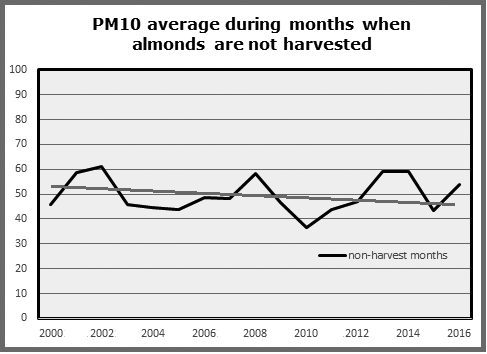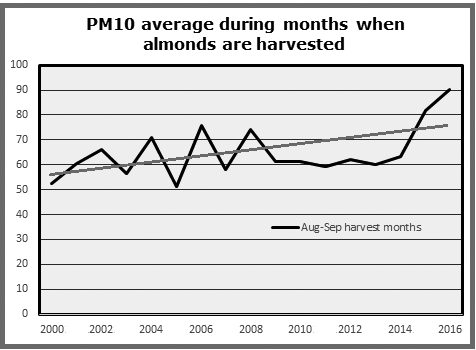
By Tom Frantz
No one living in the San Joaquin Valley is shocked to see a film of dust on their car the day after a wash. In this valley, we have a serious and health damaging dust problem. And this brown haze is worst during August and September. These are the months when almonds are harvested.
But it is not only almonds that are to blame. Agricultural operations, in general, put dust into the air as do construction activities. Sometimes, it is simply wind blowing off our overgrazed foothills or across disturbed land. Country roads don’t have shoulders, and mud is left on roads from farm equipment. Then, every vehicle pass, especially by heavy trucks, throws up a big plume of dust.
Some officials and agricultural lobbyists like to say that drought increases dust in the valley. But because most of the dust originates during actual agricultural operations, farmland that was left fallow during the recent drought actually helped to decrease our dust problem except during a few storm events with high winds.
 Dust is measured as PM10 by the Environmental Protection Agency. It consists of particles of dust or soot that are 10 microns in size or smaller. The more deadly PM2.5 is a subset of PM10 and can often be around half of any PM10 measurement. We are supposed to be in compliance with the federal standard for dust, or PM10, which is 150 micrograms averaged over 24 hours. There have been violations in recent years that the air district has been trying to justify so that more controls are not mandated.
Dust is measured as PM10 by the Environmental Protection Agency. It consists of particles of dust or soot that are 10 microns in size or smaller. The more deadly PM2.5 is a subset of PM10 and can often be around half of any PM10 measurement. We are supposed to be in compliance with the federal standard for dust, or PM10, which is 150 micrograms averaged over 24 hours. There have been violations in recent years that the air district has been trying to justify so that more controls are not mandated.
To prevent dust, ground must be watered during construction activity and farmers have to make up Conservation Management Plans for each crop they grow. The most visible results of these plans by farmers are speed limit signs on the dirt roads surrounding fields.
Most farmers tend to prevent all the dust they can during the growing season. Dust coats the leaves of plants. This allows an invasion of a type of spider mite that then defoliates the plant and greatly decreases crop yield.
Harvest time is a different story, and the crop is often brought in without much consideration of damage to plants and people. Farmers are more sensitive than they used to be about creating dust near homes and major highways but change comes slowly.
 Clearly, most of our dust comes from agricultural operations and it settles on homes, businesses and parking lots in urban areas. What happens next is insane. It seems everyone has a leaf blower to clean their driveway or parking lot. The dust is blown into the air where it mixes with the dust already there. This dust should obviously be swept with a broom and thrown in the trash or put under a tree and watered down. Why every city in the valley doesn’t ban leaf blowers is a mystery. It is probably because the air district, which should know better, doesn’t ask them to do it.
Clearly, most of our dust comes from agricultural operations and it settles on homes, businesses and parking lots in urban areas. What happens next is insane. It seems everyone has a leaf blower to clean their driveway or parking lot. The dust is blown into the air where it mixes with the dust already there. This dust should obviously be swept with a broom and thrown in the trash or put under a tree and watered down. Why every city in the valley doesn’t ban leaf blowers is a mystery. It is probably because the air district, which should know better, doesn’t ask them to do it.
The almond harvest must be the worst agricultural practice ever for creating dust. Specifically, the sweeping and blowing of almonds into windrows, and the subsequent blowing of dust off the nuts during pickup operations is unique.
In 2000, there were approximately 500,000 acres of harvested almonds in the San Joaquin Valley. This year, in 2017, there will be around one million acres. During this time of expansion, PM10 levels averaged annually have stayed about the same. But during the almond harvest, PM10 levels have risen significantly along with the expansion of crop acreage. It is past time to do something about this issue, which is damaging the lungs and health of many people and making everything filthy dirty.
There are new harvest machines that can decrease this dust significantly. The air district even gives incentive money for the purchase of these machines. But it is time to phase out this incentive money. Give the farmers five more years to purchase these clean machines with incentives and make it illegal to sell any new almond harvester that does not have this technology. Also, forbid the sale of a used harvester in five years unless it has the new dust suppressant technology. Finally, make it mandatory to retire the old technology harvesters within 10 years.
Below are graphs showing the trends in PM10 during and before/after the almond harvest periods. The air district and the almond industry must work together to protect public health and make the San Joaquin Valley a cleaner and healthier place to live.
*****
Longtime clean air advocate Tom Frantz is a retired math teacher and Kern County almond farmer. A founding member of the Central Valley Air Quality Coalition (CVAQ), he serves on its steering committee and as president of the Association of Irritated Residents. The CVAQ is a partnership of more than 70 community, medical, public health, environmental and environmental justice organizations representing thousands of residents in the San Joaquin Valley unified in their commitment to improving the health of Californians. For more information, visit www.calcleanair.org.
